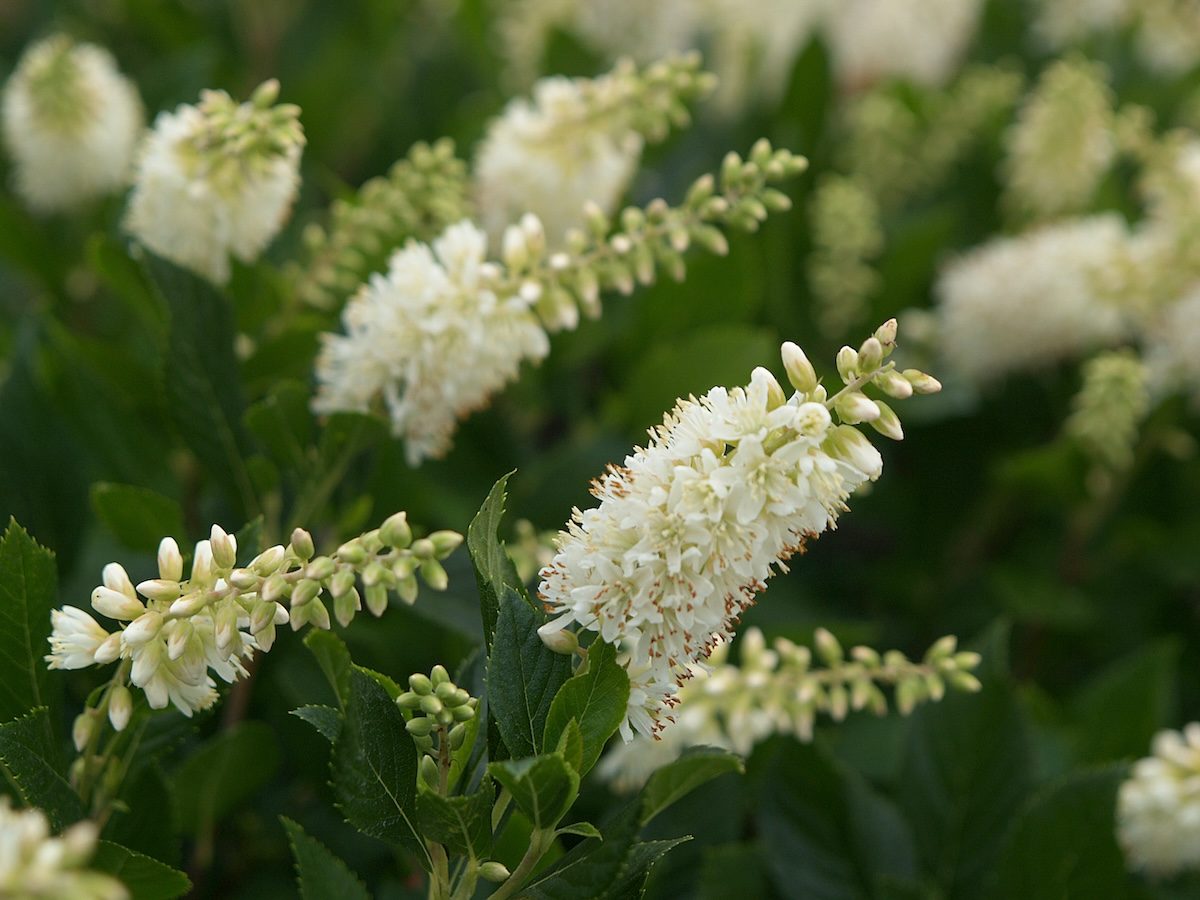Summersweet (Clethra alnifolia) is a popular native shrub that blooms with fragrant white flowers in sunny or shady conditions.

Summersweet (Clethra alnifolia): Fragrant Flowering Shrubs

On This Page
How to Grow a Summersweet (Clethra) Shrub

- Common names: Summersweet, sweet pepperbush
- Scientific name: Clethra alnifolia
- Hardiness zone: 4 to 9
- Light needs: Full sun to shade
- Watering needs: Medium to moist soil
- Size: 4 to 8 feet tall and 4 to 6 feet wide, dwarf varieties available
- Pollinators: Bees, butterflies, hummingbirds
Native to the east coast, summersweet (Clethra alnifolia) is found in moist areas such as swamps, wetlands, and floodplains. This deciduous shrub grows to 4 to 8 feet tall and 4 to 6 feet wide in full sun to partial shade. Some dwarf varieties stay under 2 or 3 feet tall.
As the name implies, summersweet provides sweet fragrance in the summer. White or pink flowers are born on 3- to 6-inch upright spikes or racemes, lighting up shady areas. The honey and clove combination attracts bees, butterflies, and hummingbirds.
In the fall, brown seed capsules resembling peppercorns develop – hence another common name: sweet pepperbush. Although there are variegated varieties, the species has medium to dark green leaves, about 2 inches long. Clethra’s autumn foliage is a pretty yellow or golden color.
When and Where to Plant Summersweet

Clethra is a very popular flowering shrub — breeders have produced varieties with more abundant flower spikes, different flower colors, and dwarf sizes suitable for small spaces. Gardeners can purchase summersweet shrubs in one-gallon containers to plant in late spring and summer.
The species is known to spread by suckers which are new stems that arise from the root system. This suckering habit makes them useful as hedges, shrub borders, and for erosion control on slopes.
Can You Grow Summersweet in Containers?
Because they do well in moist soil, they are excellent additions to rain gardens and dwarf varieties do well in containers year-round.
“Clethra is an excellent choice for year-round container growing within its hardiness range,” said Stacey Hirvela, horticulturist and marketing manager for Proven Winners ColorChoice Shrubs. “It is said that gardeners should select a plant that is two zones hardier than where they live for the best success, but I have found the moisture tolerance to be the bigger predictor of success. Usually plants that overwinter best in containers are those that can withstand those periods of wet soil, like Clethra can.”
Summersweet Pruning and Maintenance
Very little maintenance is required to keep a Clethra shrub healthy. The need for pruning and fertilizing is minimal. Although dead or diseased branches can be cut off when the plant is dormant, Stacey does not recommend pruning your shrub back.
“Overall, Clethra rarely needs pruning, nor would I recommend it, especially on those cultivars that have already been selected for appealing habits. Older specimens may benefit from the removal of very old branches to open up their centers and encourage new growth, or even rejuvenation pruning,” explains Stacey. “If growing in good conditions, fertilizer is not likely to be needed, but of course, it does boost growth. Since Clethra is fairly slow growing, that boost may be beneficial.”
Pests and Problems
Summersweet is deer and rabbit resistant with few diseases and pests. Leaves may get leaf spot in the fall but spraying is not necessary because the shrub will naturally drop its leaves by winter.
How to Propagate Summersweet
It is easy to propagate the shrub in the summer via softwood stem cuttings and division at the root level where it suckers. Gardeners can save and sow seed, but this would take longer.
“Self-seeding in the garden or landscape setting is extremely unlikely,” said Stacey. “This may be in part because they are attractive to birds which may simply eat them all. If gardeners do see small plants popping up, they are almost certainly suckers and not seedlings.”
Summersweet Varieties

Here are many of the varieties on the market today, categorized by height.
Medium to Tall Varieties
- Pink Spire: Pink buds that open to blush-pink flowers, 6 to 8 feet tall
- Anne Bidwell: White flowers blooming a few weeks later than the species, 6 feet tall
- Ruby Spice: Rose colored flowers, 6 foot tall
- Sherry Sue: White flowers, pink-red stems, 5 feet tall
- September Beauty: White flowers blooming a few weeks later than the species, 4 to 6 feet tall
- Rosea: Pink flower buds, opening to pink flowers that fade to white, 3 to 6 feet tall
- Vanilla Spice: Large white flowers, 3 to 6 feet tall
- Creel’s Calico: Creamy white variegated foliage and white flowers, 4 feet tall
- Summer Sparkler: Densely packed, thin spikes of white flowers that curl in different directions, 3 to 4 feet tall
Dwarf Varieties
- Hummingbird: White flower spikes, 3 to 4 feet tall
- Sixteen Candles: very fragrant, 3 to 4 feet tall
- Firefly: Vibrant yellow to lime green foliage, 3 feet tall
- White Dove: White flowers, 2 to 3 feet tall
- Sugartina ‘Crystalina’: sweet fragrance, 2 to 3 feet tall
Sources
- University of Maryland Extension – Summersweet
- Clemson Cooperative Extension – Summersweet Clethra
- Piedmont Master Gardeners – Clethra alnifolia
- Missouri Botanical Garden – Clethra alnifolia
- The Scott Arboretum of Swarthmore College – Summer Scents Brought to You by Clethra
- USDA – Coastal Sweet Pepperbush
About the Expert
Stacey Hirvela is a horticulturist and the marketing manager for Proven Winners ColorChoice Shrubs. She is a co-host of the award-winning Gardening Simplified radio show, YouTube show, and podcast, and is passionate gardener of native plants and herbs.




















